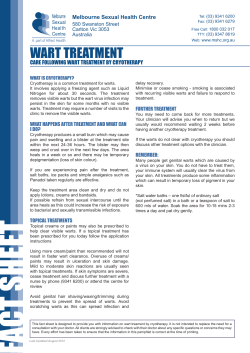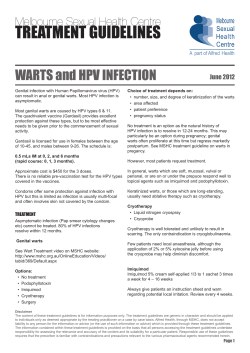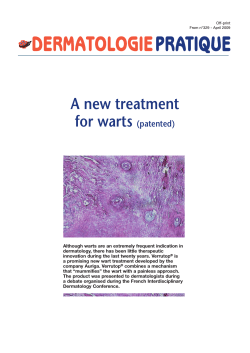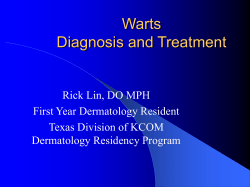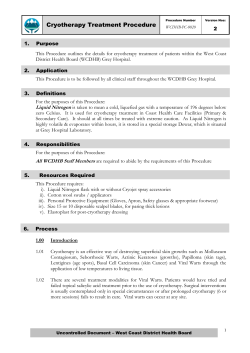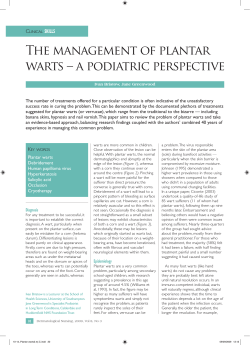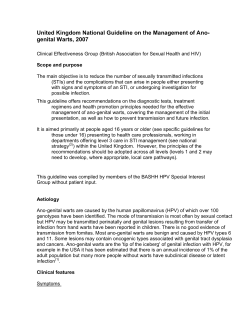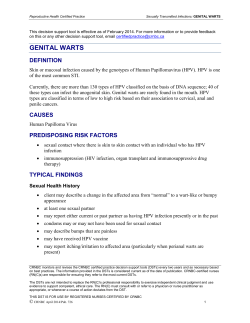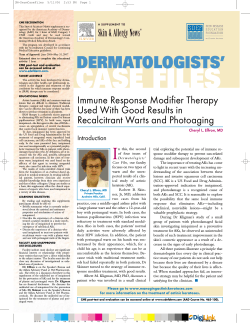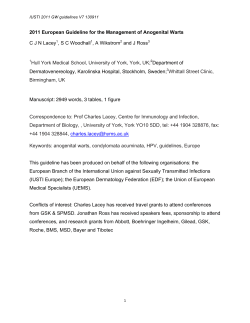
HPV Warts Human Papilloma Virus replicates in the epidermis and most
The Treatment of Warts with Intense Pulsed Light Technology Jose Gonzales, M.D., University of Puerto Rico, Department of Dermatology HPV Warts Human Papilloma Virus replicates in the epidermis and most often manifests itself in the form of an eruption and/or hyperkeratotic (flat) wart. Although the growth of hyperkeratotic warts may often be thought of as a strictly cosmetic problem, there is research that links an increase in squamous cell carcinoma to the presence of HPV. The growth of warts can also cause pain and discomfort based on location and the number of lesions. Various treatment scenarios have been followed over the years, usually with similar results. These include topical, keratolytic agents that may be effective on some lesions, excision, electrocautery, cryotherapy and CO2 laser ablation, and Pulsed Dye Laser (PDL) photocoagulation. Treatment Options Although the topicals seem to provide acceptable results in some patients, they are generally less effective on the more difficult-to-treat lesions (such as periungual warts, genital warts, etc). Ablation of the wart by CO2 lasers has historically been a popular treatment modality, but usually leaves a scar and produces an undesirable laser smoke “plume.” Because the “plume” may produce its’ own undesirable side effects, vaporization of the wart and its associated HPV particles has lost favor in recent years. There has been a long standing belief (although not yet scientifically confirmed) that “live” HPV particles exist in the laser plume. Therefore the risk of transmission of HPV to the operator or other personnel has always been a risk. Even if this serious problem does not manifest itself, the very obnoxious smell of the laser plume is itself enough of a negative to avoid actual ablation of any HPV lesions. The more obvious cosmetic problem with any type of ablative technology or cryotherapy is scarring and/or hypopigmentation. For periungual warts, flat facial warts, or in many cases genital warts, any cosmetic defect is an unacceptable result. The use of the Pulsed Dye Laser to “photocoagulate” the lesion has been shown to produce an effective treatment to eliminate the wart and also produce a cosmetically satisfactory result. The accepted method of action for the PDL is the photocoagulation of the increased vascularity that supports the growth of the hyperkeratotic wart. Multiple treatments produce a flattening of the wart and an eventual resolution of the treatment site. The localized heating due to the laser pulse may also effectively destroy the individual virus particles along with the vascular supply. With this historical perspective, the use of the Palomar LuxG Handpiece with the Palomar StarLux, MediLux or EsteLux Pulsed Light Systems was a logical choice to produce the same, effective results as the PDL. Although the treatment of periungual warts has been a dermatologic problem with its own complications and challenges (see the following independent study from the University of Puerto Rico’s Department of Dermatology), HPV warts such as condyloma accuminata in the genital area, have been equally problematic and difficult to treat. All HPV warts are epidermal in nature and should therefore be applicable for treatment with the LuxG handpiece. Expanding the application base for use of the LuxG beyond a typical treatment by a Dermatologist makes perfect sense. Gynecologists, Family Practitioners, General Practitioners, Internists, or any primary care physician who sees warts, can effectively implement this reimbursable procedure into their practice. LuxG Treatment Technique The LuxG handpiece produces a “dual-band” spectral output of 500-650 nm in the short wavelength region and 870 – 1400 nm in the long wavelength region. The short wavelength region overlaps the absorption spectrum of oxyhemoglobin and deoxyhemoglobin very well. As seen when treating vascular lesions in the skin, the excellent “uptake” of this wavelength range produces rapid destruction of unwanted, visible, telangiectatic vessels. The long wavelength range produces deep thermal heating and produces an effective rise in the temperature of the epidermis, which in turn should aid in the destruction of the HPV virus. The portion of the wavelength from 650 to 870 nm is cut out of the broad output spectrum of the flashlamp (by a proprietary dual filtration technology) in order to provide better protection to the background epidermal melanin. Therefore, the procedure can be safely performed on skin types I – IV. The output setting on the MediLux or EsteLux should be button #6 (unless the skin type is IV or V, in which case button #5 should be used). If the StarLux is used the setting should be 50 msec and 30 J/cm2. For the Medi/EsteLux machines, external cooling of the tip of the LuxG handpiece with Cryospray should be undertaken before the treatment commences. On the StarLux, active contact cooling is built into the handpiece tip. Contact with the lesion is essential as is the use of LuxLotion™ or of some other “index matching/cooling” material such as Humatrix. The lotion is thinly applied to the lesion or lesions and the tip of the LuxG handpiece is placed in light contact with the skin. Because the vasculature of the wart is the target, excessive pressure by the tip on the skin will compress the blood out of the base of the wart and the treatment will be less effective. If the lesion is excessively hyperkeratotic, it may be necessary to “pare down” the lesion with a scalpel in order to minimize the total number of treatments. If not, the treatment will still work, but it may take considerably more treatment sessions. Because the lesion is raised, it is also necessary to treat around the sides of the lesion. In other words, if you picture the lesion as half a sphere, it is important to treat the sides of the sphere as well as the top of the sphere. Because the HPV replicates in the epidermis, it is also important to effectively treat 1-2 mm around the periphery of the lesion to minimize recurrence. Due to the fact that these warts generally have an increased level of melanin as well as increased vasculature, the lesion should darken after the treatment. Treatment sessions should be spaced out to approximately once a month or sooner, if possible (this depends entirely on the healing of the lesion after the previous treatment). In general, four to six treatment sessions should be planned, but as you can see in the Periungal Warts study, the actual number of treatments averaged 2.8 for the seventeen patients in the study. Post Treatment After thoroughly treating the wart, a post treatment antibacterial (ie. Polysporin) should be applied to the treated lesions for at least the first few days. If the lesion is on an area that might be scraped or irritated, a bandage should be applied if practical. The lesion may become “crusted” over the next few days, but that is to be expected. Most importantly, the tip of the handpiece needs to be cleaned before being used on the next patient. Reimbursement Although the StarLux, MediLux, and EsteLux are predominantly used for the treatment of cosmetic conditions, which are non-reimbursable, cash-generating procedures, the use of Palomar systems for wart treatments does produce a source of reimbursable revenue. These reimbursable procedures may provide a very strong foundation for paying the lease and any ongoing costs of the Palomar system as the cosmetic business grows. The following CPT codes have been successfully used for billing. They are meant only as examples of attainable repayment, but there may be other useful codes as well. Determination of the proper billing codes should be decided by each individual physician and it is not Palomar’s intention to dictate which codes may be successfully applied for each treatment. CPT 57513 CPT 56501 CPT 17000 CPT 17003 CPT 17110 CPT 54050 laser destruction of cervical warts $176.00 laser destruction of warts on the vulva $126.69 general destruction of a lesion $57.58 added to the above to cover treating lesions #2 thru # 14 $9.71/lesion destruction of flat warts $82.28 destruction of lesions on the penis $126.69 Although reimbursement will vary greatly from carrier to carrier, the above figures provide a reasonable basis to show that these procedures can certainly provide a substantial payback toward the purchase of a device. Periungual Warts Periungual warts may originate from the hyponychium or the proximal and lateral nail folds. They are usually caused by HPV serotypes 1, 2 and 4.1 Children and young adults are more commonly affected. Fingernails are affected more often than toenails. Development of warts in the nail unit is favored by maceration and trauma, especially nail biting.1 Periungual warts are generally asymptomatic and rarely cause complications. Some patients complain of pain. Large lesions located in the proximal nail fold may cause compression of the nail matrix leading to dystrophy of the nail plate. Spread of the viral infection, by bringing the affected hands to other parts of the skin or to mucosal surfaces, is also a concern. Even more alarming are reports of squamous cell carcinoma developing from warts caused by HPV 16.2,3 Warts located in the periungual area are considered difficult to treat. They are often resistant to common therapeutic modalities. There is also concern when treating these lesions that the nail matrix may be disturbed, leading to permanent nail damage. We sought to determine the safety and efficacy of an intense pulsed light source for the treatment of periungual warts. Patients and Methods A total of 17 patients with 50 periungual warts were included in the study. The age of the patients ranged from four to 53 years (mean 16.5 years). Nine patients were male and eight were female. Individual lesions measured between 0.3 and 2.5 cm. The number of warts per patient varied from one to 13. Warts were measured and photographed on the first visit, before each treatment and after complete resolution. Complete resolution was indicated by complete restoration of the epidermal ridge pattern at the site of the lesions after treatment. Thicker warts were pared with a #15 blade prior to therapy. When necessary, 4% lidocaine cream (Rx Ela-Max) was applied 30 minutes prior to treatment. An intense pulsed light source (Palomar EsteLux System) was used to irradiate warts at each visit. Early in the study patients were treated with a handpiece that emitted light with wavelengths of 700-1200 nm, pulsewidth of 20 ms and fluences of 10-12 J/cm2. Later, another handpiece (the LuxG) became available which emitted light at 500-670nm and 8701200 nm with a pulsewidth of 20 ms and fluence of 30 J/cm2. A single patient was treated with the first handpiece only. Three patients received their first treatments with the first handpiece and were later switched to the LuxG. The remaining 13 patients were treated with the LuxG only. Two sequential pulses were delivered per treatment point. Patients were retreated up to a maximum of 6 times. Treatment intervals varied from one to eight weeks. Patients who achieved complete response were followed up by telephone 12 to 16 months after the last treatment to determine if recurrence of the lesions had occurred. Results Sixty-five percent (11/17) of the patients achieved complete resolution (Figures 1 and 2). Forty-eight percent (24/50) of the individual lesions were cleared. The average number of treatments required for complete resolution was 2.8 (varied from one to six). The mean age of the patients who responded satisfactorily to treatment was 12.5 years, which was lower than the mean age of the non-responders (mean age 24 years, Table 1). The average number of lesions was also lower in the group of patients who responded to treatment than in the group of non-responders (Table 1). Complete Resolution Non-responders Age (years) Mean 12.5 Range 4-42 Range 5-53 Mean 24 Number of warts Range 1-7 Mean 2 Range 1-13 Mean 4 Immunocompromised 0 1 Table 1. Comparison of patients who achieved complete clearance with IPL treatment of periungual warts with those who did not respond. A B Figure 1. A: Wart involving the proximal nail fold, hyponychium and nail bed. B: Three months after three IPL treatment sessions. A Figure 2. A: Warts involving the proximal nail folds of various fingers as well as the dorsum of the digits. B: Lesions in the proximal nailfolds resolved completely. Note that lesions in the dorsum of the fingers show partial regression. These lesions eventually resolve completely. B The patient treated only with the handpiece that emitted light at 700-1200 nm achieved complete resolution of his lesions. Two of the three patients treated with both handpieces obtained complete response. One patient had a diagnosis of Wegener’s granulomatosis and was receiving immunosuppressive drugs. This patient’s wart did not respond to intense pulsed light therapy. Minimal pain during treatments was reported by three patients. The discomfort was prevented by applying 4% lidocaine cream 30 minutes prior to subsequent treatment sessions. No purpura, eschar, changes in pigmentation, scarring or nail dystrophy were observed. When patients who had achieved complete response were contacted by telephone 12 to 16 months after the last treatment, none had experienced recurrence of their lesions Discussion Spontaneous regression of warts is often observed and seems to be mediated by cell-mediated immunity4. Spontaneous resolution is less frequent in large, long-standing lesions and in immunocompromised patients5. The natural course of periungual warts appears to be similar to that of warts in other areas of the skin. Periungual warts often recur and tend to be resistant to most therapeutic modalities. When choosing a treatment for warts, the number of lesions, location, duration, age of patient, immunologic status and skill of the doctor performing the procedure should be taken into account. Definite cure is not guaranteed by any treatment modality since none is directed at eradicating the pathogenic virus. Both surgical and non-surgical approaches are commonly utilized. Keratolytic agents such as topical salicylic acid 1040%, topical sensitizers such as squaric acid dibutylether and diphencyprone, topical imiquimod, intralesional bleomycin and oral cimetidine have all been reported to be effective. Surgical approaches such as excision, electrosurgery, crytherapy, CO2 and Er:YAG laser ablation are also commonly used. Gibbs, et al6 systematically reviewed the literature on local treatments of cutaneous warts. They concluded that even when a wide range of local treatments are available for treating warts, high quality research on the efficacy of various local treatments is lacking. Most trials were highly variable in methods and quality. Fewer studies are available that focus on the treatment of periungual warts. Cure rates reported for cryotherapy are high7 but are generally dependant on the physician’s ability to perform the procedure. When performed incorrectly, irreversible matrix destruction may result. Intralesional bleomycin is frequently used to treat periungual warts, particularly those that have been resistant to other forms of treatments. In a study8 of 38 patients with 143 warts, 67.8% of the lesions showed complete resolution after one or two bleomycin injections. All responsive warts developed a hemorrhagic eschar that eventually healed without scar. Immunotherapy with topical imiquimod was effective in treating 80% (12/15) of patients with periungual warts in a recent study.9 Lasers have also been used in the treatment of periungual warts. In a retrospective study,10 40 patients with 69 subungual and periungual warts were treated with CO2 vaporization. Cure rate at 10 month follow-up was 57.4% (39/68). In another study, complete cure was observed in 71% (12/17) of patients after CO2 laser vaporization11. Pulsed dye lasers cause selective microvascular destruction of dilated capillaries of the warts. In an observational study, 83% of periungual warts achieved complete resolution after photocoagulation with a flashlamp-pumped pulsed dye laser. The cure rates observed in our study are comparable to those obtained in these studies. Intense pulsed light (IPL) systems deliver pulses of broadband incoherent light. Cutoff filters block transmission of certain wavelengths, increasing selectivity. As with pulsed dye lasers, the energy delivered by the system is possibly absorbed by oxyhemoglobin in the dilated capillaries of warts. Targeting the lesion’s blood supply leads to regression of the lesion. Localized stimulation of the immune system seems to play a role in light therapy of other diseases13, and may also contribute to the therapeutic response and long term efficacy observed in our study. The low occurrence of adverse events (only minimal pain during treatment in three patients) is a great advantage over other treatment modalities. In conclusion, intense pulsed light therapy seems to be a safe and effective method for the treatment of periungual warts. Older age, increased number of lesions and immunosuppression are factors that may contribute to resistance to treatment. 1. Tosti A, Piraccini BA. Warts of the nail unit: surgical and nonsurgical approaches. Dermatol Surg 2001; 27:235-239. 2. Ashinoff R, Li JJ, Jacobson M, Friedman-Kien AE, Geronemus RG. Detection of human papillomavirus DNA in squamous cell carcinoma of the nail bed and finger determined by polymerase chain reaction. Arch Dermatol 1991;127(12):1813-1818. 3. Moy RL, Eliezri YD, Nuovo GJ, Zitelli JA, Bennett RG, Silverstein S. Human papillomavirus type 16 DNA in periungual squamous cell carcinoma. JAMA 1989; 261(18):2669-2673. 4. Stanley M, Coleman N, Chambers M. The host response to lesions induced by human papillomavirus. Ciba Found Symp 1994;187:21-32. 5. Morison WL. Viral warts, herpes simplex and herpes zoster in patients with secondary immune deficiencies and neoplasms. J Dermatol 1975; 92:625-630. 6. Gibbs S, Harvey I, Sterling J, Stark R. Local treatments for cutaneous warts: systematic review. BMJ 2002; 325: 461-464. 7. Kuflik EG. Specific indications for cryotherapy of the nail unit. Myxoid cysts and periungual verrucae. J Dermatol Surg Oncol 1992;18(8):702-6. 8. Amer M, Diab N, Ramadan A, Galal A, Salem A. Therapeutic evaluation for intralesional injection of bleomycin sulfate in 143 resistant warts. J Am Acad Dermatol 1988;18(6):1313-6. 9. Micali G, Dall’Oglio F, Nasca MR. An open label evaluation of the efficacy of imiquimod 5% cream in the treatment of recalcitrant subungual and periungual cutaneous warts. J Dermatolog Treat 2003;14(4):233-6. 10. Lim JT, Goh CL. Carbon dioxide laser treatment of periungual and subungual warts. Australas J Dermatol 1992;33(2):87-91. 11. Street ML, Roenigk RK. Recalcitrant periungual verrucae: the role of carbon dioxide laser vaporization. J Am Acad Dermatol 1990;23(1):115-20. 12. Kauvar ANB, McDaniel DH, Geronimus RG. Pulsed dye laser treatment of warts. Arcg Fam Med 1995;4:1035-1040. 13. Papageorgiou P, Katsambas A, Chu A. Phototherapy with blue (415 nm) and red (660 nm) light in the treatment of acne vulgaris. Br J Dermatol 2000;1042:973-978. Palomar Medical Technologies, Inc., Burlington, MA 01803 n Tel. 800-PALOMAR (725-6627) or 781-993-2300 n www.palomarmedical.com Palomar MediLux, Palomar EsteLux, Palomar StarLux, and LuxG are trademarks of Palomar Medical Technologies, Inc. © 2004, Palomar Medical Technologies, Inc. JY04-5KKP PN1553-0003
© Copyright 2025
